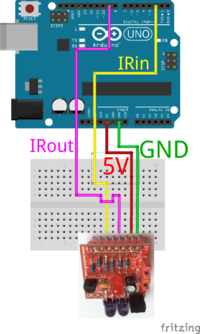DIYIR - Soldering Kit: Difference between revisions
| Line 30: | Line 30: | ||
Always make sure to power the module from the same voltage as the logic level of the system you are connecting to (5v->5V '''or''' 3V3->3V3 '''DO NOT''' mix voltage levels or you will damage your MCU or module) | Always make sure to power the module from the same voltage as the logic level of the system you are connecting to (5v->5V '''or''' 3V3->3V3 '''DO NOT''' mix voltage levels or you will damage your MCU or module) | ||
== Use with | == Use with IRremote == | ||
DIYIR can be used with IRremote, AnalysIR and other Libraries(E.g. IRLib) by connecting as follows: | DIYIR can be used with IRremote, AnalysIR and other Libraries(E.g. IRLib) by connecting as follows: | ||
[[File:Wiring_Arduino_UNO.png|200px|thumb|left|DIYIR Wiring for | [[File:Wiring_Arduino_UNO.png|200px|thumb|left|DIYIR Wiring for IRremote, IRLib & AnalysIR]] The image shows wiring for 5V opertion. To use with 3V3 set the position of JP2 accordingly. To Test try out all of the [https://github.com/z3t0/Arduino-IRremote/tree/master/examples example sketches] provided with the library. By Default IROUT is connected to Pin 9. There si no default for IRIN, but we prefer to use Pin 2, which is the default when using with AnalysIR. | ||
You can find the IRremote library on [https://github.com/z3t0/Arduino-IRremote GitHub]. Make sure to read the [https://github.com/z3t0/Arduino-IRremote/blob/master/README.md README] before starting. | You can find the IRremote library on [https://github.com/z3t0/Arduino-IRremote GitHub]. Make sure to read the [https://github.com/z3t0/Arduino-IRremote/blob/master/README.md README] before starting. | ||
The latest version of IRLIB is also available via [https://github.com/cyborg5/IRLib2 GitHub]. | The latest version of IRLIB is also available via [https://github.com/cyborg5/IRLib2 GitHub]. | ||
Revision as of 06:00, 19 September 2018
Where To Purchase
Visit AnalysIR's IR Shop where you will find this and a range of similar Infrared solutions. You can also purchase DIYIR via our Tindie Store
Data Sheet
The data sheet can be found by clicking here
Assembly Instructions
Follow the step by step guide DIYIR Assembly Instructions
Connection Header P1
You can use Header P1 to connect the DIYIR module to your Microcontroller. Check out the section below about wiring to an Arduino UNO. Each signal appears twice on P1, in case you need to daisy-chain any of the signals or just for testing with a multimeter or oscilloscope.
+ Pin - Connect this to the power rail of your microcontroller. Usually if your MCU is powered from 5V via USB and runs at 5V this is suffiecient. (If your MCU is powered from 3V3 then connect this pin to the 3V3 rail of your MCU).
- Pin - This is the ground pin and should be connected to the GND pin of your MCU.
IN Pin - This is the IRin pin for your MCU and on the UNO is connected to Pin2 (or any other pin you designate in your firmware)
OUT Pin - This is the IRout pin for your MCU and on the UNO is connected to Pin9 (which is the default for Irremote or any other pin you designate in your firmware)
Jumper Settings
JP1 - Insert this to increase IR Output power by a factor of 2x.
JP2 - Set to 5V for 5V operation and to 3V3 for 3V3 operation. (In 3V3 mode one of the IR emitters is removed from the circuit)
Note, it may be possible to operate both emitters @ 3V3 by powering from 3V3 and setting JP2 to 5V mode, However, the red LED may not visibly blink when a signal is being sent.
Always make sure to power the module from the same voltage as the logic level of the system you are connecting to (5v->5V or 3V3->3V3 DO NOT mix voltage levels or you will damage your MCU or module)
Use with IRremote
DIYIR can be used with IRremote, AnalysIR and other Libraries(E.g. IRLib) by connecting as follows:

The image shows wiring for 5V opertion. To use with 3V3 set the position of JP2 accordingly. To Test try out all of the example sketches provided with the library. By Default IROUT is connected to Pin 9. There si no default for IRIN, but we prefer to use Pin 2, which is the default when using with AnalysIR.
You can find the IRremote library on GitHub. Make sure to read the README before starting.
The latest version of IRLIB is also available via GitHub.